- Home
- About
- Map
- Trips
- Bringing Boat West
- Migration West
- Solo Motorcycle Ride
- Final Family XC Trip
- Colorado Rockies
- Graduates' XC Trip
- Yosemite & Nevada
- Colorado & Utah
- Best of Utah
- Southern Loop
- Pacific Northwest
- Northern Loop
- Los Angeles to NYC
- East Coast Trips
- 1 Week in Quebec
- Southeast Coast
- NH Backpacking
- Martha's Vineyard
- Canadian Maritimes
- Ocracoke Island
- Edisto Island
- First Landing '02
- Hunting Island '02
- Stowe in Winter
- Hunting Island '01
- Lake Placid
- Chesapeake
- Provincetown
- Hunting Island '00
- Acadia in Winter
- Boston Suburbs
- Niagara Falls
- First Landing '99
- Cape Hatteras
- West Coast Trips
- Mojave 4WD Course
- Colorado River Rafting
- Bishop & Death Valley
- Kauai
- Yosemite Fall
- Utah Off-Road
- Lost Coast
- Yosemite Valley
- Arizona and New Mexico
- Pescadero & Capitola
- Bishop & Death Valley
- San Diego, Anza Borrego, Joshua Tree
- Carmel
- Death Valley in Fall
- Yosemite in the Fall
- Pacific Northwest
- Utah Off-Roading
- Southern CA Deserts
- Yosemite & Covid
- Lake Powell Covid
- Eastern Sierra & Covid
- Bishop & Death Valley
- Central & SE Oregon
- Mojave Road
- Eastern Sierra
- Trinity Alps
- Tuolumne Meadows
- Lake Powell Boating
- Eastern Sierra
- Yosemite Winter
- Hawaii
- 4WD Eastern Sierra
- 4WD Death Valley +
- Southern CA Deserts
- Christmas in Tahoe
- Yosemite & Pinnacles
- Totality
- Yosemite & Sierra
- Yosemite Christmas
- Yosemite, San Diego
- Yosemite & North CA
- Seattle to Sierra
- Southwest Deserts
- Yosemite & Sierra
- Pacific Northwest
- Yosemite & South CA
- Pacific Northwest
- Northern California
- Southern Alaska
- Vancouver Island
- International Trips
- Index
- Tips
- Books
- Photos/Videos
- Search
- Contact
Yosemite National Park, CA
Tuesday, October 25, 2016 - 10:00am by Lolo
255 miles and 6 hours from our last stop - 7 night stay
Travelogue
Day 1 – Hiking in Hetch Hetchy
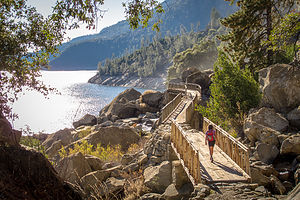 Intact Hetch Hetchy BridgeAfter 30 years of visiting Yosemite National Park and having hiked every trail the Valley has to offer and most of those in Tuolumne Meadows as well, it was finally time to explore the often forgotten and rarely visited Hetch Hetchy, in the northwest corner of the park.
Intact Hetch Hetchy BridgeAfter 30 years of visiting Yosemite National Park and having hiked every trail the Valley has to offer and most of those in Tuolumne Meadows as well, it was finally time to explore the often forgotten and rarely visited Hetch Hetchy, in the northwest corner of the park.
This was the place that famed conservationist John Muir thought rivaled Yosemite Valley in grandeur and fought so hard to protect from the politically powerful men in San Francisco that wanted to dam the river and turn its valley into a reservoir. As we all know, Muir lost the good fight and many believe that the loss hastened his death in 1914, a year after a bill was signed to fund the dam project.
Anyone interested in learning more about this controversial battle should definitely attend one of the weekly performances of “Conversation with a Tramp: An Evening with John Muir” given every Wednesday night at the Yosemite Theater (behind the Visitor Center). It is such an unbelievably worthwhile experience. The actor, Lee Stetson, has been playing the role of John Muir since 1983, and trust me, he will keep you mesmerized and totally convinced that you are back in 1913 anxiously waiting with him in his study for the news of Hetch Hetchy’s fate.
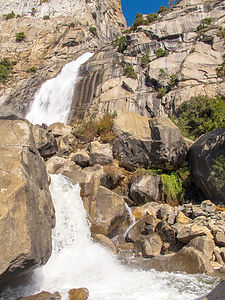 Wapama FallsIronically, this part of the park is so much less visited than the Valley that the feeling of solitude and remoteness that surrounds one here is probably much closer to the way John Muir had experienced Yosemite.
Wapama FallsIronically, this part of the park is so much less visited than the Valley that the feeling of solitude and remoteness that surrounds one here is probably much closer to the way John Muir had experienced Yosemite.
The 40-mile drive from the Valley takes about an hour and a half. We took the Big Oak Flat Road north, but rather than turn west onto 120, we continued on Evergreen Road through the Stanislaus National Forest. This was now new territory for us. Since we were no longer officially in the park, there were some privately-run establishments, such as the Evergreen Lodge and Tavern, which I am embarrassed to say, I had no idea even existed. It looked quite quaint and cozy.
At the end of Evergreen Road, we came to the Yosemite entrance station -- that’s right, you actually have to leave Yosemite and re-enter it again to get to Hetch Hetchy.
At the entrance gate, we were extremely disappointed to hear that the 13-mile (RT) trail to Wapama and Rancheria Falls was closed after two miles because the bridges across Wapama Falls had been damaged by the heavy rains of the previous week. These same heavy rains, which had treated us to the most spectacular waterfalls we had seen in 30 years of Yosemite visits, were now going to ruin my day. I guess you can’t have it all. At least we would get to see controversial dam and reservoir, and there always was that quaint little Tavern back at the Evergreen Lodge.
From the entrance gate, we drove another 8 miles along the twisty, narrow Hetch Hetchy Road to the Day Hikers parking area by the O’Shaughnessy Dam. There was no one else here.
 Lolo and Hetch HetchyAs we walked across the dam and gazed out across the reservoir (squinting a little to block out the water), we could definitely see how John Muir compared this place to Yosemite Valley. There was even a little El Cap, just to the left of Wapama Falls. Later, we even found a miniature Half Dome. I guess we shouldn’t have been so surprised, as the same forces that formed Yosemite Valley shaped and created this valley as well.
Lolo and Hetch HetchyAs we walked across the dam and gazed out across the reservoir (squinting a little to block out the water), we could definitely see how John Muir compared this place to Yosemite Valley. There was even a little El Cap, just to the left of Wapama Falls. Later, we even found a miniature Half Dome. I guess we shouldn’t have been so surprised, as the same forces that formed Yosemite Valley shaped and created this valley as well.
At the end of the dam, we walked through a 500-foot, dark tunnel, before turning right onto the trail to Wapama and Rancheria Falls. In spring time there are usually three waterfalls to see along this trail, but for whatever reason, Tueeulala Falls, at 1 ½ miles, was not running.
We finally came across some fellow hikers – two girls who were turning back because they encountered a black bear on the trail. Oh great. Although I hesitated to continue at first, Herb encouraged me to forge ahead, suggesting we make noise to announce our presence along the way. While Herb chose to taunt the bear with a chant of, “No grizzly,” I more wisely just tooted my whistle every 100 yards or so. We’ll never know whose method worked better, but in either case, we never came across the bear.
As we neared Wapama Falls at about 2.3 miles, we came to the “trail closed” sign we had been warned about. They obviously had placed the sign well before any trail issues, so we decided to just take a little peek around it with the hope of getting a photo of the falls and the damaged bridge.
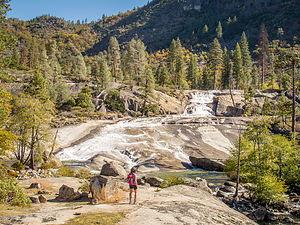 Rancheria FallsWhen we reached the falls and the series of bridges that crossed it, we were surprised to discover that they were perfectly intact, with the exception of one 6-foot section of railing down on the first one. We have hiked some pretty precarious trails over the years that have truly frightened and humbled me – and I admire the National Parks for giving people the freedom to make their own decisions as to what they can safely handle -- but this one did not seem to be a safety issue at all.
Rancheria FallsWhen we reached the falls and the series of bridges that crossed it, we were surprised to discover that they were perfectly intact, with the exception of one 6-foot section of railing down on the first one. We have hiked some pretty precarious trails over the years that have truly frightened and humbled me – and I admire the National Parks for giving people the freedom to make their own decisions as to what they can safely handle -- but this one did not seem to be a safety issue at all.
So, rightly or wrongly we continued on, past lovely Wapama Falls, excited that we could now complete the 13-mile hike we had originally planned. For the next 4 miles, the trail traced the reservoir’s edge, often rising high above the water, providing fabulous views of Kolana Rock across the water.
At 6.5 miles, we reached Rancheria Falls, which unlike the free-falling Wapama Falls, is a series of rolling cascades pouring over terraces of polished granite. It was a lovely spot to have lunch before starting the trek back.
Although we usually prefer loop hikes to out-and-backs, hiking in the opposite direction can still provide unique views and vantage points.
I am so glad we finally made the trip up to Hetch Hetchy.
Days 2 and 3 – Rainy Days in the Valley
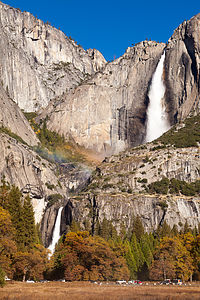 Rainbow on FallsThe forecast was pretty grim for the next two days, but we were determined to make the best of it. Yesterday had been so beautiful for our hike in Hetch Hetchy – bright sun, blue skies, and mid-70s. But bright blue skies are much less interesting photographically than cloudy, rainy days. At least, that’s what we kept telling ourselves.
Rainbow on FallsThe forecast was pretty grim for the next two days, but we were determined to make the best of it. Yesterday had been so beautiful for our hike in Hetch Hetchy – bright sun, blue skies, and mid-70s. But bright blue skies are much less interesting photographically than cloudy, rainy days. At least, that’s what we kept telling ourselves.
Herb loves photographing the Valley, and we probably literally have thousands of photos from our previous visits, but this was the first time we were seeing it draped in fall colors. Herb was so excited that he almost forgot how much he hates damp and cold.
So, we spent two quite fun and rewarding days, driving and hiking to our favorite spots around the Valley, sneaking between the raindrops whenever we could. I only wish I had more to say about it, because it would give Herb space on this page to post more of his wonderful photos.
It gets dark so early in the Valley this time of year, especially on a dreary day, that by 5:30 or so we were back in the motorhome hunkered down for the night. Autumn would be perfect if it wasn’t for these short days, but then again, it’s that low light that gives things that magical glow.
It was Friday night, so we stayed up late (which meant after 9:00) to greet the kids when they arrived for the weekend – always a happy occasion.
Day 4 – Rock Climbing Cookie Cliff
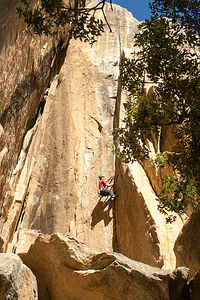 Tommy on Cookie MonsterWell it looked like Andrew, Tommy, and Celeste had brought the sunshine with them, and we woke up to an absolutely stellar day.
Tommy on Cookie MonsterWell it looked like Andrew, Tommy, and Celeste had brought the sunshine with them, and we woke up to an absolutely stellar day.
As is always the case now when the kids join us on one of our trips, the plan for the day was to squeeze in as much climbing as possible. Andrew had already researched and selected the targeted climbing area for the day, so no time need be wasted pouring over climbing guides in the morning. The forecast for tomorrow was rain again, so they were going to make every minute of daylight today count.
The plan for the day was to drive few miles out of the Valley along El Portal Road to a rock wall called Cookie Cliff, known for containing some of the world’s best crack climbs. Andrew had asked us to scout it out the day before, so that we wouldn’t have to waste any of their precious and limited time in Yosemite trying to find it. We meant well, but because of the rain, Herb and I had only gotten as far as finding the parking lot alongside the road, about a half mile down the canyon from the Cascade Creek Bridge. Scrambling up the wet rocks to find the actual specific climb was just not gonna happen.
Climbing areas are often challenging to find, as they usually do not have well-marked trails, and in many cases, the approach involves scrambling over rocks to its base. Well, this one was of the rock scrambling variety and we managed to use up a little too much energy (I did at least) going a little too far to the right and winding up at the base of Cookie Sheet rather than Cookie Cliff.
 Herb attacks the Cookie MonsterRather than going all the way back to the parking area and starting over again, Tommy had us wait while he found a way to traverse across the boulders to the area we really wanted. I didn’t mind, as that turned out to be the only workout I got all day, because the climbs on Cookie Cliff were way over my climbing ability.
Herb attacks the Cookie MonsterRather than going all the way back to the parking area and starting over again, Tommy had us wait while he found a way to traverse across the boulders to the area we really wanted. I didn’t mind, as that turned out to be the only workout I got all day, because the climbs on Cookie Cliff were way over my climbing ability.
Like most physical activities, climbing should involve a warm-up on an easy climb to get the muscles loose and the blood flowing before diving into something really hard. The boys had hoped to start on Outer Limits, a 5.10c classic Yosemite crack climb, before proceeding to their real goal, Cookie Monster, a more difficult 5.12a. However, as is often the case on weekends, climbers were already on their warm-up climb.
The smart thing would have been to wait for their turn on Outer Limits, but Andrew was so anxious to get on Cookie Monster that he just couldn’t wait. We didn’t even know that he was on the climb, as the start was atop a rock pile, not visible from where we were sitting. Celeste was belaying him. It was an extremely strenuous climb, a “pumpfest” in climbers’ terms, and he made it up to the last bolt before falling. He was so spent from his climb that his eyes could hardly focus. I feel bad that we missed his efforts.
When Outer Limits opened up, Tommy led and set up a top rope so that Herb and Celeste could try it as well. It took awhile for Andrew to refocus (literally) and take a go on it himself.
The Cookie Monster was still there with Andrew’s gear 90% of the way to the top. Tommy took advantage of the hard work Andrew had done and managed to complete the climb, setting a top rope up for Herb and Celeste. Andrew, almost fully recovered by this point, made another attempt and was able to complete it.
I pretty much did nothing but photograph their efforts.
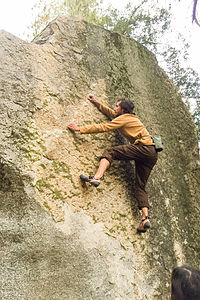 Andrew unraveling the Kor ProblemThere was still a little daylight left and the boys (and Celeste) still wanted to climb some more, so we headed back into the Valley to Camp 4, the famous rock climbers’ campground located near the base of Yosemite Falls. Some of the world’s most renowned climbers have used it as their base when climbing in Yosemite.
Andrew unraveling the Kor ProblemThere was still a little daylight left and the boys (and Celeste) still wanted to climb some more, so we headed back into the Valley to Camp 4, the famous rock climbers’ campground located near the base of Yosemite Falls. Some of the world’s most renowned climbers have used it as their base when climbing in Yosemite.
So important was this site to the climbing community, that when its removal was threatened in the late 1990s, a campaign was started to save it. It worked, and today it is listed on the National Register of Historic Places for "its significant association with the growth and development of rock climbing in the Yosemite Valley during the 'golden years' of pioneer mountaineering.”
So here we were, on hallowed climbing ground. Even if you don’t climb, it’s fun to just walk through this camp and watch the bouldering that goes on here.
Bouldering is quite different from trad and sport climbing, which is done with ropes and gear on a rock wall. Instead, it is done on freestanding boulders, where the routes are generally short. To help cushion the inevitable fall, crash pads are placed on the ground and other climbers (and, in our case, sometimes even climbers’ mothers) spot the person bouldering by standing below with arms outstretched, ready to protect the climber’s head from hitting any rocks off the pad.
Also, bouldering has its own difficulty grading system. Rather than the 5.0 – 5.14 grades used for trad and sport climbing, boulder routes are graded from V0 to V14.
As with selecting the climbing wall for the day, the boys had also scouted out ahead of time a boulder that they wanted to work on – the Kor Problem, a V3 techy face climb on the east side of Camp 4. As far as difficulty, a V3 is about equivalent to a 5.11b trad/sport climb.
 Some Midnight Lightning in Camp 4Boulder routes are referred to as boulder problems, because figuring them out and completing them is very much like solving a problem – finding just the right moves and holds and putting the sequence together. Many climbers will work on a difficult boulder problem for weeks or even years. It is often quite elegant and beautiful to watch, and a cause for celebration when achieved.
Some Midnight Lightning in Camp 4Boulder routes are referred to as boulder problems, because figuring them out and completing them is very much like solving a problem – finding just the right moves and holds and putting the sequence together. Many climbers will work on a difficult boulder problem for weeks or even years. It is often quite elegant and beautiful to watch, and a cause for celebration when achieved.
I am happy to report that Andrew, Tommy, Celeste, and even “Old Man" Herb were able to solve the Kor Problem.
It was quite dark by the time they finished, but as we walked through Camp 4, we noticed that there was a group of climbers with headlamps still working on “Midnight Lightning,” the most famous bouldering problem in the world and an iconic part of the history of Yosemite rock climbing.
It is easily identified by a chalk lightning bolt, which was originally drawn on it in 1978 by John Bachar, the second climber to complete it (Ron Kauk was first). Since that time, the bolt has been erased by those that consider it graffiti and redrawn by those that think it an essential part of the history and spirit of Yosemite climbing. I liked it - it reminded me of a petroglyph.
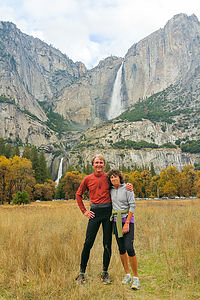 Happy Valley RunnersMidnight Lightning is a V8 problem, and just to get an idea how difficult it is, this is a description of its crux (the most difficult part of a climb):
Happy Valley RunnersMidnight Lightning is a V8 problem, and just to get an idea how difficult it is, this is a description of its crux (the most difficult part of a climb):
“the most difficult move on Midnight lightning is a "spider-monkey” swing 15 feet off the ground. The climber must suspend himself by the fingertips of his left hand, swing around a ledge of rock and propel himself far enough up, about four feet, to grab a precarious fingertip hold with his right hand. To do that he has to create momentum from stillness."
Andrew and Tommy were intrigued – how could they not be. It was such a part of the history of Yosemite Valley climbing.
They were warmly greeted by the climbers already working on the problem-- perhaps due to the crash pads they added to the pile spread out on the ground. They generously offered their headlamps in return. With no delusions of being able to complete it, they took a few shots at it with the rest. For a rock climber, I would have to think it was a thrill just to touch it.
While we were there, someone actually completed it. It was like watching a beautiful, perfectly executed dance. I was glad we were there to see it.
Day 5 – Ahwahnee Brunch and Rain Returns
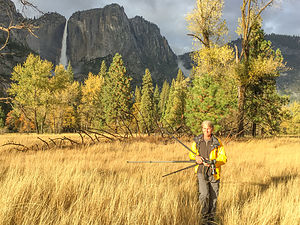 My AnselAs forecast, we awoke to the pitter patter of rain tapping on our roof. Actually, it was more like a pounding than a tapping. I felt so bad for the drenched tent campers, and ever so grateful for our cozy Lazy Daze.
My AnselAs forecast, we awoke to the pitter patter of rain tapping on our roof. Actually, it was more like a pounding than a tapping. I felt so bad for the drenched tent campers, and ever so grateful for our cozy Lazy Daze.
It has become somewhat of a tradition for us to conclude our family time together in the Valley with Sunday morning brunch at the Ahwahnee -- yes, I refuse to use the name Majestic to refer to this iconic national park lodge and probably never will. The fact that the weather was so miserable made the idea seem all the more inviting.
No matter how many times we go to the Ahwahnee, it never gets old for me. As soon as I step foot in the Grand Lounge, with its rustic wooden-beamed ceiling, floor-to-ceiling windows, and cozy nooks and fireplaces, I immediately relax and the day-to-day concerns of the world outside of Yosemite seem to drift away – even the upcoming election – well almost.
 Lolo still wandering around meadowSunday brunch was wonderful as always. As usual, the waiter tried to push the buffet, which at $48 a person is very pricey for breakfast, but instead we asked for the ala carte menu and ordered from there – a much more reasonable, but yet very tasty and ample option. I highly recommend either the French Toast or the Royal Arches Breakfast.
Lolo still wandering around meadowSunday brunch was wonderful as always. As usual, the waiter tried to push the buffet, which at $48 a person is very pricey for breakfast, but instead we asked for the ala carte menu and ordered from there – a much more reasonable, but yet very tasty and ample option. I highly recommend either the French Toast or the Royal Arches Breakfast.
The rain had slowed down a bit and there was even the occasional peek of sunshine, so after breakfast Herb and his camera went for his traditional post-brunch photography walk out behind the Ahwahnee and down to the Merced.
In the meantime, the kids and I set up camp at a table in the back sunroom and spent a pleasant hour playing Hearts. While I almost “shot the Moon” (almost is never a good thing in Hearts), Celeste actually pulled it off, possibly due to her ability to display a much better poker face than the stupid grin I had during my attempt.
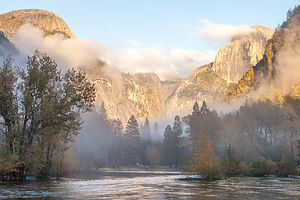 Merced and the DomesHerb joined us back in the Lounge looking happier and more enthusiastic than I have ever seen him on a cold, rainy day. Although he had taken this walk dozens of times in the past, the raindrops on the autumn leaves created a whole new visual experience to photograph. He had found a new friend – a little yellow maple leaf that somewhat unintentionally appeared in the foreground of one of his photos that then became his “supermodel.” Fortunately, I am secure enough in our relationship to not mind that there are literally 10 times more pictures of this leaf than there are of me.
Merced and the DomesHerb joined us back in the Lounge looking happier and more enthusiastic than I have ever seen him on a cold, rainy day. Although he had taken this walk dozens of times in the past, the raindrops on the autumn leaves created a whole new visual experience to photograph. He had found a new friend – a little yellow maple leaf that somewhat unintentionally appeared in the foreground of one of his photos that then became his “supermodel.” Fortunately, I am secure enough in our relationship to not mind that there are literally 10 times more pictures of this leaf than there are of me.
Back at the RV the kids packed up and headed back to San Francisco and real life. It was back to being just Herb and me (and probably that damn leaf that he had hidden somewhere).
Day 6 – Running and Photographing around the Valley
 Falls X 2It was our last full day in the Valley and it looked like the weather was going to cooperate with us again today. Really strange weather pattern this trip – beautiful sunny days alternating with rainy days the whole week. I guess it was better than a string of rainy days in a row.
Falls X 2It was our last full day in the Valley and it looked like the weather was going to cooperate with us again today. Really strange weather pattern this trip – beautiful sunny days alternating with rainy days the whole week. I guess it was better than a string of rainy days in a row.
We decided to spend our last day, driving around the Valley stopping at and photographing our favorite spots:
• Sentinel Bridge - best view of Half Dome
• Swinging Bridge - great view of Yosemite Falls
• El Cap Meadow - nice sunny spot to look for tiny climbers on the granite monolith
• Valley View – river view with El Cap on the left and Cathedral Rocks on the right
• Wawona Tunnel View - most iconic view of the Valley
• Bridalveil Falls – one of the few falls in the Valley that flows all year
• Cathedral Beach – best river reflections of El Cap
• Yosemite Chapel – cutest little church I have ever seen
Not all time in the Valley is play time. After our photo tour, we addressed the less glamorize side of motorhome life - getting a propane fill at the Yosemite Garage, food shopping at the Village Store for supplies for the remainder of our trip to Pinnacles, and pooping the motorhome (as Herb likes to call it) at the Upper Pines dump station.
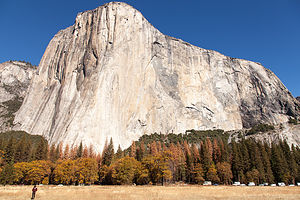 Lolo - Oh, and El Cap tooWe were fortunate in our timing at the dump station, however, in that we got to meet a lovely couple, also in a Lazy Daze, who invited us to come over to their motorhome that evening for a glass of wine.
Lolo - Oh, and El Cap tooWe were fortunate in our timing at the dump station, however, in that we got to meet a lovely couple, also in a Lazy Daze, who invited us to come over to their motorhome that evening for a glass of wine.
Somehow we hadn’t found time this week to go for a run in the Valley – one of my favorite activities – so we rectified that by going out for a 7.7-mile run along the bike paths and dirt trails of the Valley Loop Trail.
Later that evening, armed with flashlight, headlamps, and a bottle of wine, we wandered over in the pitch black to our new dump station friend’s (Ted and Molly’s) campsite in the North Pines Campground. We had a lovely time sharing Lazy Daze modification tips and travel tales. It’s always fun to meet people along the road. You already start off with so much in common.
Well, another successful Yosemite trip had come to a close, but now that we live so nearby, it’s nice to be able to just more casually say “See you soon!”
Description
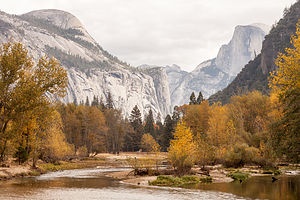 Dueling DomesYosemite National Park lies near the eastern border of California in the heart of the Sierra Nevada Mountains. Its spectacular waterfalls, soaring granite cliffs, and lush meadows are just a few of the reasons it is considered by many to be nature’s ultimate masterpiece. In the words of John Muir, “it is surely the brightest and the best of all the Lord has built.”
Dueling DomesYosemite National Park lies near the eastern border of California in the heart of the Sierra Nevada Mountains. Its spectacular waterfalls, soaring granite cliffs, and lush meadows are just a few of the reasons it is considered by many to be nature’s ultimate masterpiece. In the words of John Muir, “it is surely the brightest and the best of all the Lord has built.”
This description will focus on Yosemite Valley, which is the section of the park we visited. Although the Yosemite Valley is just a small portion of Yosemite’s 761,268 acres, it is part receives 95% of its visitors. In fact, an estimated 4.1 million people visit the Valley each year, making it extremely crowded.
Two one-way roads traverse Yosemite Valley: the east-bound Southside Drive and the west-bound Northside Drive, which wind through woodlands and meadows along the base of the 3,000-foot-high granite cliffs. As of today, cars are still allowed to enter and drive through the valley, but visitors are highly encouraged to park their vehicles and use the park’s free shuttle bus, which stops at the major attractions in the valley.
Virtual Tour of Yosemite Valley Highlights
- As you enter the valley, the first sight you’ll see is the 620-foot Bridalveil Falls flowing down from a hanging valley to the valley floor. From the parking area, a short paved path leads to the base of the falls. This is one of the few falls in Yosemite that does not completely dry up in the summer.
- Just past the Bridalveil Fall parking area, the Southside Drive begins to trace the Merced River. Soon El Capitan comes fully into view. This 3,000 foot high granite cliff is the largest single piece of exposed granite in the world and one of the most famous landmarks in Yosemite. If you look closely, you might see small dots that are actually rock climbers along its face.
- Continuing east on the Southside Drive are two riverside picnic areas and beaches: Cathedral Beach and Sentinel Beach.
- Right after the Sentinel Beach parking area is the trailhead for the 4-Mile trail, which ascends more than 3,200 feet from the valley floor to Glacier Point and one of the most spectacular views of the valley.
- A short distance further is Swinging Bridge, another picnic and swimming area. This area is also the westernmost point of the 8-mile bicycle loop that goes through the eastern part of the valley. From this point on, the bike path parallels the road.
- Next stop is the picturesque tiny Yosemite Chapel where many outdoor enthusiasts choose to exchange wedding vows.
- Now you enter the congested and developed portion of the valley.
- Right past the chapel, you can either take a left onto Sentinel Bridge towards Yosemite Village and the park exit, or you can continue straight towards Curry Village, the campgrounds, and Happy Isles Nature Center. For now, let’s stop at Sentinel Bridge for what is probably the most spectacular Half Dome viewpoint in the park. It’s a great spot for a photograph of Half Dome with the Merced River in the foreground.
- Continuing east on the Southside Drive, you pass Housekeeping Camp and Curry Village. Curry Village has lodging, restaurants, bicycle and raft rentals, a grocery store, and other shops. Curry Village is also one of the main parking areas in the valley.
- From Curry Village you can either take Northside Drive across the Ahwahnee Bridge back to Yosemite Village and the park exit, or continue east to the campgrounds. The Happy Isles Nature Center is also this way, but only shuttle buses are allowed on the road to it.
- The Happy Isles Nature Center features exhibits on the natural history of the park. It also serves as the trailhead for some of the best hikes in Yosemite. 1.5 mile trail leads to the top of Vernal Falls and then continues another 1.5 miles to the top of Nevada Falls (two waterfalls that flow even in the summer time). From there you can continue even further into the backcountry of Yosemite, including the cable route up the back of Half Dome.
- From Curry Village, the Northside Drive crosses the Ahwahnee Meadow, a wonderful spot to gaze at Half Dome during sunset, and enters Yosemite Village, the main center of visitor services in the park. Here you’ll find the park’s main Visitor Center, restaurants, lodging, shops, a grocery store, a post office, a medical clinic, the Ansel Adams Gallery, an Indian Cultural Exhibit and more. It’s also a good place to park your car and jump on the shuttle.
- A short dead end road from Yosemite Village leads to the majestic old Ahwahnee Hotel, which has played host to Queen Elizabeth, President John F. Kennedy, and Clint Eastwood, to name a few. This beautiful six-story rock structure offers tremendous views from every room. Within the hotel is the elegant and quite expensive Ahwahnee Dining Room (jackets required for dinner).
- Back on the Northside Drive heading west from Yosemite Village, the next stop is the Yosemite Falls parking area. At 2,425 feet, Yosemite Falls is the highest waterfall in North America. It is actually three waterfalls in one, with an upper, middle and lower section. A short walk from the parking lot along a paved walk leads to the base of Lower Yosemite Falls. This is the most visited landmark in the valley. Except in summer when the fall temporarily dries up, you’ll be sure to be covered in spray.
- A little further west on the Northside Drive is Yosemite Lodge, which marks the end of the developed area of the park going west.
- Right after Yosemite Lodge is Sunnyside Campground/Camp 4, a place where most rock climbers choose to congregate. From this campground begins the popular and strenuous Yosemite Falls hike, which ascends 2,600 feet from the valley floor to the top of the Upper Falls. The views from the top are incredible.
- Continuing west, there is nothing but woods and meadows from which to enjoy the views. Along the road there are several pullouts where you can stop and walk down to the Merced River for a swim. Just after the El Capitan Bridge, you’ll come to the El Capitan Meadow where you’re sure to find people looking through binoculars at the miniscule rock climbers clinging to the granite face.
- Just to the west of El Capitan, Ribbon Falls plunges over 1,600 feet down to the valley floor. It is the seventh highest waterfall in the world. However, it too dries up in the summer time.
- Finally the road nears the end of the Northside Drive at Valley View where El Capitan, on the left, and Cathedral Rocks, on the right, frame a magnificent valley view.
Several guided bus tours are also available. The 2-hour Valley Floor Tour is a great way to get acclimated. Visitors ride through the valley in an open tram while a guide leads a informative discussion of Yosemite’s history and geology. There are many photo stops along the way. In addition, there are bus tours out of the valley to Glacier Point, the Mariposa Grove of sequoia trees, and Tuolumne Meadows.
Although much of Yosemite can be enjoyed from the comforts of your car or a shuttle, the best way to truly experience Yosemite is do get out and experience it more directly..
Things to do in Yosemite
- Hike one of the many trails around the valley, ranging from an easy walk to the base of Lower Yosemite Falls to the strenuous 16-mile round trip hike up the back of Half Dome via cables
- Take an overnight backpacking trip
- Bike along the 12 miles of bicycle paths that loop through the Valley. Rentals are available at Curry Village and Yosemite Lodge.
- Rock climb in one of the premier climbing places in the world
- Raft down the calm waters of the Merced River through the valley. Rentals are available at Curry Village.
- Swim or tube in the Merced River. Besides the designated beaches, there are many pullouts along the road from which you can walk down to the river.
- Join one of the many ranger walks, which are offered daily
- Take a free art class at the Yosemite Art and Education Center
- Photograph the amazing scenery of the valley and surrounding granite cliffs
- Browse the Ansel Adams Gallery and see some of the photographs that first made Yosemite famous
- Relax in the meadow while gazing up at Half Dome or El Capitan
- Dine at the 5-star Ahwahnee Hotel, where presidents and royalty have stayed
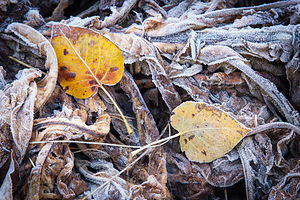 Frosty LeavesAlthough many try to see Yosemite in a day, it is best to devote several days to seeing all the park has to offer. Besides the numerous hotels, lodges, and cabins in the Valley, there are three RV campgrounds: Upper Pines (238 sites), Lower Pines (60 sites), and North Pines (81 sites). That’s less than 400 campsites to accommodate all the people that want to camp here.
Frosty LeavesAlthough many try to see Yosemite in a day, it is best to devote several days to seeing all the park has to offer. Besides the numerous hotels, lodges, and cabins in the Valley, there are three RV campgrounds: Upper Pines (238 sites), Lower Pines (60 sites), and North Pines (81 sites). That’s less than 400 campsites to accommodate all the people that want to camp here.
Since these campgrounds usually fill-up within the first hour they become available, it is essential to make your reservations as soon as possible. Campground reservations are available in blocks of one month at a time, up to five months in advance, on the 15th of each month at 7 am Pacific time. For example, if your arrival date is July 15 through August 14, the first day you can make reservations is March 15. The National Park Reservation System can be found at www.recreation.gov. Good luck!
- 1 of 3
- next ›
Yosemite National Park location map in "high definition"
Javascript is required to view this map.
